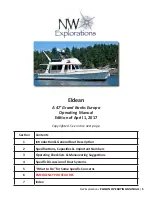
69
3237 • X6 02/2018
OWNER’S MANUAL
NAVIGATION RULES AND AIDS
6
BUOYS
Most anchored floating markers are referred to as buoys.
Buoys have many uses and color schemes, and they can
vary in size and shape.
The most commonly used buoy colors are white, red,
green, yellow and black. Buoys may be unlighted or
lighted. Some are audible, while others have both audible
and visual signals. Lights, bells and horns on buoys aid
in night boating or poor visibility conditions. Buoys with
unique light-flashing characteristics are identified on
nautical charts with the specific flashing pattern.
Become familiar with the specific buoys used in the
waters where you are boating. Contact local authorities
for specific information and/or navigational aid charts for
your waterways.
SPHERICAL SAFE
WATER MARKER
UNLIGHTED
BELL BUOY
LIGHTED BUOY
CAN BUOY
SPAR BUOY
NUN BUOY
KC-0052C-A
Figure 6-4
Mooring Buoys
The only buoys you are permitted to moor to are mooring
buoys. Mooring buoys are white with a blue horizontal
stripe. Mooring to a navigation buoy, regulatory markers
or lateral markers is illegal.
WHITE WITH BLUE BAND
MAY SHOW WHITE
REFLECTOR OR LIGHT
KC-0020C-A
Figure 6-5
DAYMARKS/DAYBOARDS
Daymarks or dayboards are fixed visual markers in
the water. The markers are commonly attached to a
post or piling and are sometimes accompanied by a
light. Daymarks are either red or green and are usually
triangular- or square-shaped, though their shapes can
vary. Daymarks often display numbers, which act as
navigation guides. Red daymarks are usually triangular
and sometimes show an odd number. Green daymarks
are usually square and sometimes show an even
number. The numbers on the markers are sequential and
increase from seaward.
KC-0021C-A
STARBOARD
DAY
MARKER
PORT
DAY
MARKER
Figure 6-6
C34_Coupe.indb 69
2/8/2018 3:41:47 PM
















































